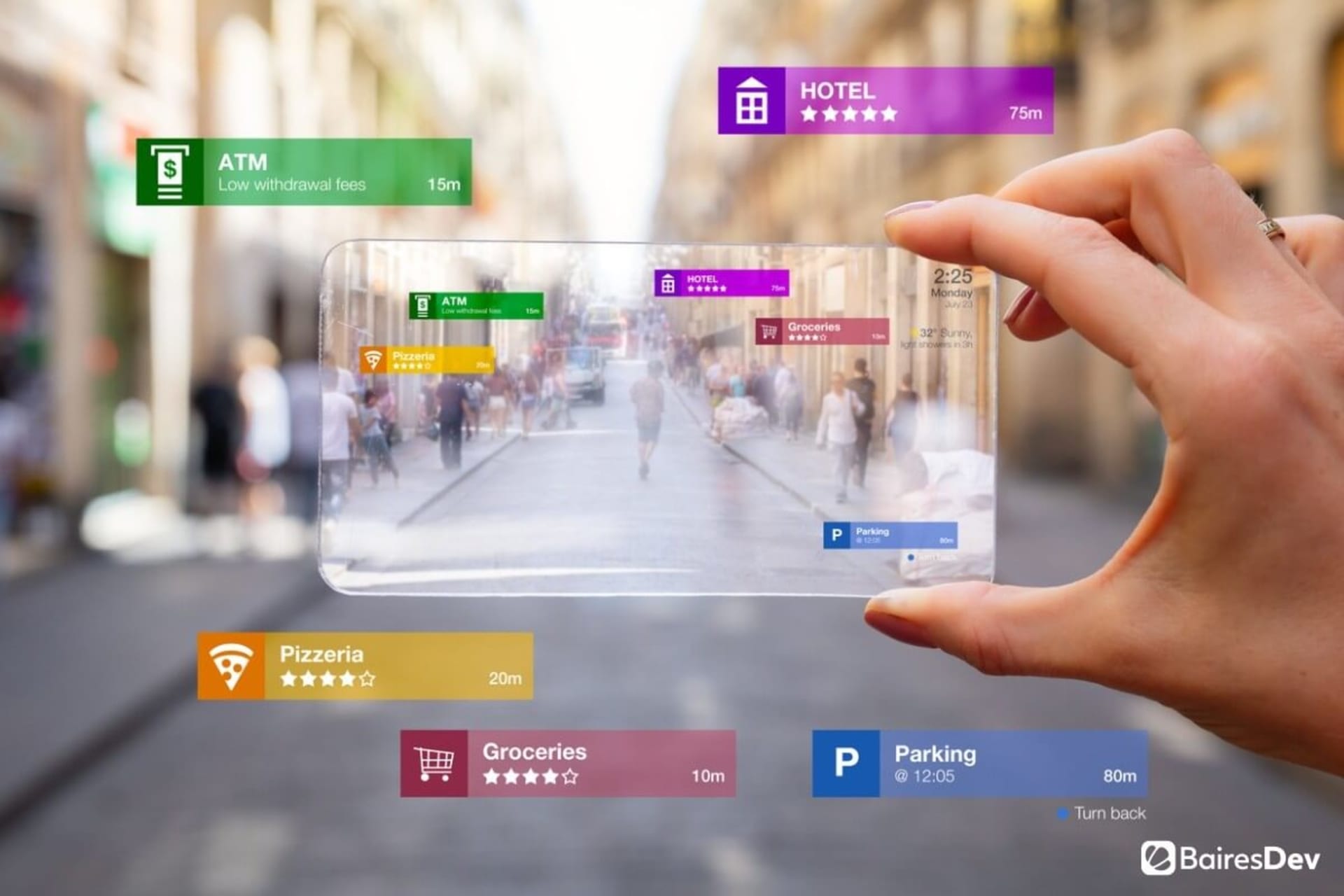Augmented Reality (AR) connects the physical world to the virtual world. It’s a visually interactive technology in which virtual elements are layered digitally over real-world components. It’s an impressive technology, with uses in fields such as healthcare, e-commerce, advertising, and navigation.
What is AR?
AR works by creating 3-D models of different objects and laying them over objects in your surroundings. You can change the object’s size, color, and shape to adjust to your view. This is different from Virtual Reality (VR), which consists of an entirely digital environment with no ties with the real world.

AR works by enhancing auditory, haptic and somatosensory inputs. The simulations are done via sensors and markers. Deep learning algorithms train models to accurately detect objects through camera images and create a visual output after combining virtual elements with the input data.
For example, suppose you’re shopping for furniture in an online store. You can use the website’s AR feature to superimpose that furniture (object) over your room to see how it’d look.
The first use of AR happened in advertising when BMW used it for marketing its new car model. It was later adopted by companies for different use cases.
AR might feel like a niche technology but that’s far from being true. In 2021, almost a billion people used AR. This number is supposed to reach 1.73 billion by 2024. AR is growing rapidly, and many prominent companies such as Walmart, Apple, Microsoft, and Niantic, have started using AR to improve their offerings.
Can you use AR for navigation?

AR allows companies to superimpose specific digital objects such as pictures, text, or sounds over real-world objects. Thus, it helps businesses create highly interactive and robust platforms. Even though AR has many amazing applications, one of its most effective applications is in navigation.
You can use AR for inter-city navigation. Through this technology, you can easily identify and navigate through places such as shopping malls, museums, and parks. AR facilitates path logistics along with visual orientation for effective navigation. AR applications can highlight and superimpose directions on what your camera sees, along with instruction points for easy readability.
You can also use AR for finding routes in case of an emergency. Augmented Reality is more effective in case of catastrophe since it uses optimization modes for efficient steering. This is better than standard navigation methods since it reduces cognitive overload.
You can also use AR for measuring speed. An AR application can monitor the speed of your vehicle relative to other vehicles and advise accordingly on things like turns and passes. This improves performance and enhances driver safety. You can also use it for automobile maintenance and repair.
Examples of AR fitting into navigation
Navigation applications that implement AR use several inputs such as the user’s location via GPS, initial camera measurement, and object location. They also track object movement. Sensors collect this information and connect it to IMUs of the objects in motion. The data is used to design and overlay components relative to the real-time movement of the user.
Many companies have started using AR to improve their navigation services. Some of the examples are
This is one of the most successful AR implementations in navigation. It uses AR for loading illustrated navigation instructions and traffic data onto live images. The map also has details such as house figures, street names, and traffic lights status, which you can use for efficient navigation.
Google Live View superimposes information on top of Google Maps. It helps its users in location identification and direction assistance. It also allows you to identify landmarks through multi-modal navigation. Furthermore, you can use LiveView for location sharing and global localization.
-
ARCity (part of ARKit)

This iOS product simplifies metropolitan navigation for Apple applications through AR. It has 3 modes, augmented maps, reality navigator, and urban visual positioning. In addition, the application has a built-in compass and allows users to find the shortest routes.
Benefits of AR in navigation
1. Displaying data
AR allows businesses to gather and display comprehensive data to their users. Real-time visualization can be done for both text and graphics. This provides the users with a more realistic overview of the location. For example, museums can display additional information to their visitors, such as history, mythologies, and facts of the objects in display.
2. Saves time
AR saves the users’ time and allows them to access the best routes and services. AR applications show detailed data on traffic with live images that commuters can use to plan their travel. Real-time maps allow you to make better driving decisions by projecting the best routes and overlays onto the screen.
3. Customer experiences
You can customize user interaction through AR based on their present location and interests. AR applications can guide their customers to nearby facilities, such as restaurants, parks, and hotels customers might like.
It makes traveling seamless, increases brand loyalty, and improves user engagement. This is very important for customer retention.
Challenges you can face while implementing AR in navigation
AR integration in navigation doesn’t come without challenges. There are still a few issues to sort out before companies globally adopt AR into navigation strategies.
There’s the case of user acceptance. Since AR is a new technology, many people are unaware of its benefits. They may have doubts about its perception and usage, which creates a marketing challenge for companies wanting to adopt it.
It also poses certain cybersecurity challenges. Since AR apps are tracking customer location, you might need to comply with strict regulations. This means you might have to go through multiple bureaucratic channels before the product launch.
Integrating AR at a geographic level for the different locations also implies steep costs. You will need a lot of resources to develop such applications, especially talented AR engineers that might be hard to come by.
Can AR actually change the way we look at maps?
AR integrates digital and physical components to create a superimposed visual input for its users. It’s a game-changer when it comes to navigation. Integrating AR into current maps will help save time, improve customer experiences, and increase travel opportunities.
Of course, certain issues need to be addressed before adoption. But AR has the ability to transform the tech world. And, in a certain way, it’s already doing so.







